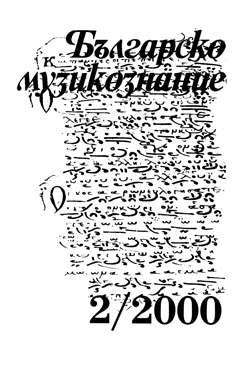Редактирането на Стихирара от Йоан Кукузел - нови данни
Editing John Koukouzeles' Sticherarion - New Data
Author(s): Svetlana KujumdzievaSubject(s): Music
Published by: Институт за изследване на изкуствата, Българска академия на науките
Summary/Abstract: The scholarship has linked the name of John Koukouzeles with the great re formative work in the Balkans by the end of the 13th and the first half of the 14th century. This work was related to the replacement of the Studite Typikon (Ordo) with this one of Jerusalem, and respectively, to the changes in liturgical praxis which gave an imprint on religious music. Koukouzeles is credided with the compilation of the new chant book linked to the new Jerusalem Typikon-Akolouthiai-Anthology. 01. Strunk claimed that. the new revised version of the Heirmologion which appeared by the very beginning of the 14th century was result of the reformative work of John Koukouzeles. He found some relation between this Heirmologion and some settings of the Sticherarion from the same time and suggested that Koukouzeles revised part of the repertory of the Sticherarion as well. J. Raasted in his last publications continued the study in this direction and established that Koukouzeles revised not only part of the Sticherarion but the entire one and this revision was parallel to that of the Heirmologion. In Bulgarian libraries were preserved some valuable Sticheraria which have remined unknown as a whole up to now. Their recent investigation comfirmed the conclusion of J. Raasted. The repertory of these Sticheraria and especially that one which 01. Strunk called the “marginal” is identified in the article. The specific features of that repertory which allow us to speak about a new version of the Sticherarion are shown. Also, the clues leading to Koukouzeles as an editor of this chant book are discussed. The questions about dynamics between oral and written traditions based on the inclusion of some pieces transmitted orally up to that time (14th century) and on numerous musical variants written in red ink parallel to that in black are posed. Some manuscripts in Bulgarian language finally, preserved in Sinai, are drawn as an evidence to the considered problems.
Journal: Българско музикознание
- Issue Year: 2000
- Issue No: 2
- Page Range: 32-62
- Page Count: 31
- Content File-PDF

